#ancient iberians
Photo

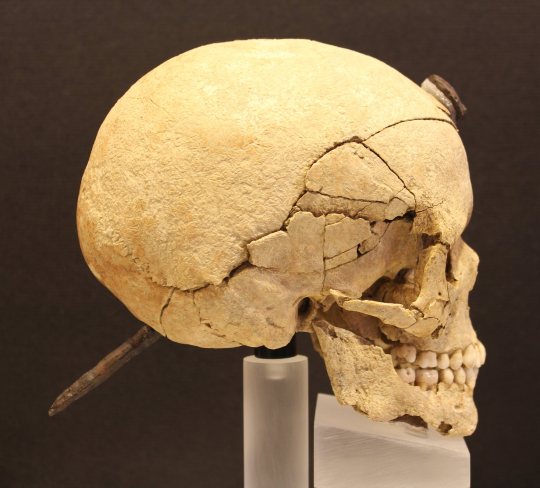
In various cities of the Ancient Iberians (Ancient Iberians were the indigenous cultures that lived in the Eastern coast of the Iberian peninsula before they got conquered by the Roman empire), archaeologists have often found skulls perforated by a nail. All of them have been found in the cities located in what nowadays is the Northern half of Catalonia (Ancient Iberian cultures, though related to each other, varied a lot area to area).
These are believed to be the skulls of their enemies, who were captured and beheaded. The enemy’s heads were nailed to the city walls or above the entrance door to houses, together with their weapons. Most of these heads belonged to individuals of the male sex, though some are female and a few belonged to children.
The Ancient Iberian language hasn’t been deciphered and their contemporaries didn’t write much about them, thus many aspects of their culture aren’t known for certain. Archaeologists have the hypothesis that this practice could be related to the way Celts exhibited the heads and hands of their enemies as war trophies, or related to a belief present in the ancient Mediterranean according to which cutting someone’s head off stopped them from reaching immortality. The Gauls even passed down the beheaded heads of their enemies to their children, as a prized possession that brought prestige. It’s a possibility that Northern Iberians were in touch with this practice.
Photos from the Ancient Iberian site Ullastret (Comarques Gironines, Catalonia) posted on National Geographic. Information from Rovirà i Hortalà, 1998 and MAC Ullastret.
#història#arqueologia#ullastret#catalunya#ancient iberians#antiquity#ancient history#ancient#archaeology#archeology#protohistory#war history#historical#historical artifacts#artifacts#anthropology#bones#european history#europe
115 notes
·
View notes
Text

Mosaico de los Amores, Spain
#archaeology#mosaic#spain#art#jaén#andalucía#history#antiquity#cástulo#roman#ancient rome#ancient world#mosaics#europe#european#iberian peninsula#iberia#hispania#linares#floors#tiles#archaeologist#mosaico de los amores#mosaico#photography#photograph
400 notes
·
View notes
Text

(+ rough sketches)

Celtiberia OC!!
#hetalia#hws celtiberia#i love ancient iberian history smmmm#especially tartessos#and hannibal & himilce!¡#AND THE ROMAN CONQUEST#😫😫#i want to get more into it!!!#hws oc#mine#fanart
32 notes
·
View notes
Text

Dama de Baza mágica. This drawing is inspired by an ancient iberian sculpture called "La dama de Baza" (The lady of Baza)
#iberian art#iberia#damadebaza#ancient civilizations#ancient world#fantasy#fantasy art#goblin#goblins#ancient art#ancient sculpture#baza
87 notes
·
View notes
Text
my favourite iberian indigenous names have to be burrus and reburrus. they never fail to make me giggle everytime i come across them
#they were quite popular as well. like so popular roman authors tended to use burrus to talk about iberians in general#kinda like using juan to talk about hispanics or idk pierre for french people#for non-hispanics#burro means donkey#it also means stupid#and we use 'reburro' to say someone is extra stupid#also this proves burro the word comes from prerroman times which <3#in my experience#almost all spanish words that don't have a clear origin and have a lot of 'rr' and other hard sounds are probably prerroman#(and most likely iberian tho it could be celtic)#arroyo and berrocal are two common examples as well#burro arroyo berrocal. you can see the similarities#also except burro they tend to be natural features and stuff which makes sense#an arroyo is a stream. a berrocal is a particular rock formation#this also proves at least for me the connection between ancient iberian languages as euskera#euskera is also characterized by a lot of hard sounds and if i didn't know them already#i'd think arroyo or berrocal were basque words
14 notes
·
View notes
Photo

Un dia en Porto... by Edorta Kartiber On-Off.
#edortakartiber#bridgeofponteluisiinporto#bridge#river#europe#iberian#peninsula#north#region#oporto#porto#district#portugal#ancient#architecture#art#civil#historical#history#infrastructure#iron#metal#monument#old#neighborhood#transport#roof#tradition#traditional#typical
17 notes
·
View notes
Text
Classics-tober Day 7- Persephone??

~ATAEGINA~
Ataecina or Ataegina was an ancient chthonic goddess worshipped by Iberians, Lusitanians and Celtiberians.
She was considered the goddess of spring, nature and fertility. Since it’s believed that her name could have meant “reborn”, she’s associated with the Underworld and the cycles of vegetation. Because of this, since Roman times she was identified with Proserpina and, by association, with Persephone.
Furthermore, she seamed to have been considered a goddess of healing, though her devotees also asked her to curse other people.
Within her know attributes are the goat and the cypresses.
———————————————————————
Alright, some people will kill me for not drawing the queen of the underworld herself, but the moment I read “you can add additional Ancient Med cultures if you can link them to the characters ” I saw an opportunity I couldn’t pass.
Lately, in my mission to expand my mythological knowledge, I started researching somewhere close to me: the prerroman Iberian Gods.
I HAVE a lot to say about how unfortunate is that we know so little about Iberian/Celtiberian religion. Meanwhile, I’ll try to someday draw the gods we do know about so I can give them their long awaited spotlight.
#myart#my art#Iberian gods#Iberian mythology#ataegina#ataecina#I’m actually not sure if the ancient Iberians had anthropomorphic gods?#anyways one day I’ll actually draw Persephone I swear#and after that I will take other goddesses related to the underworld and draw them being queens together#mythology#classicstober#classicstober23#once again I’m late to the date#and I had to skip medeas day#AND I HAVE TO DO ICARUS AS WELL#I’ll see if I can do something fast between today and tomorrow
20 notes
·
View notes
Text
A research team has uncovered the long-lost ancient city of Titiakos and the remains of a Roman military camp in Soria Spain. This fascinating find has brought to light the traces of battles, minted coins, and the strategic genius of early Roman engineering.
#Celt#Iberian#Celtiberian#coin#projectile#Spain#coins#Roman Colonization & Expansion#Roman Military & Warfare#ancient#history#ancient origins
25 notes
·
View notes
Text
These are beautiful.
30 notes
·
View notes
Text
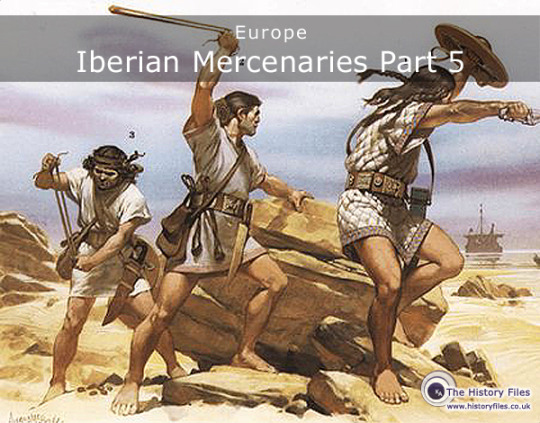
Iberian Mercenaries 5: Women Warriors
While Iberian women themselves did not serve as mercenaries, there are nevertheless numerous reports by ancient writers, as there are with Celtic peoples, of women warriors in Iberia.
#history#historyfiles#iberia#iberian mercenaries#mercenaries#women warriors#ancient iberia#ancient europe#ancient spain
4 notes
·
View notes
Text

Lady of Baza, a seated limestone painted statue of a woman found within the pre-Roman necropolis known as Cerro del Santuario, an Iberian necropolis in Baza, Spain. It dates from around 400 B.C.
16 notes
·
View notes
Text

🗡️ Check out this incredible Falcata! ✨Based on a historic Iberian original from the National Archeological Museum of Madrid, this reproduction by Deepeeka is stunning.
🗡️Crafted with a blued blade of tempered C60 high carbon steel, this Falcata is designed for powerful, helmet-splitting chops and fearsome cuts. The forward-swept recurve blade adds an extra touch of intimidation.
🗡️ The full tang construction ensures durability, with two polished bone grip scales riveted directly to the thick blade tang. The hilt is beautifully adorned with highly detailed plates and an antiqued brass knuckle bar.
🗡️ comes with a wooden scabbard tightly bound in red leather. The scabbard features brass chape, banding, and hanging rings, allowing you to wear it at an angle or vertically with a shoulder baldric (baldric not included).
🗡️Own a piece of history and unleash the power of this ancient weapon. Get your hands on the Deepeeka Falcata today.
#Kult of Athena#KultOfAthena#WorldOfKOA#Deepeeka#Madrid Iberian Falcata#National Archaeological Museum of Madrid#sword#swords#weapon#weapons#blade#blades#Spanish Swords#Spanish Weapons#Short Swords#European Swords#European Weapons#Instagram#videos#Ancient Swords#Ancient Weapons#C60 High Carbon Steel#Battle Ready
5 notes
·
View notes
Text
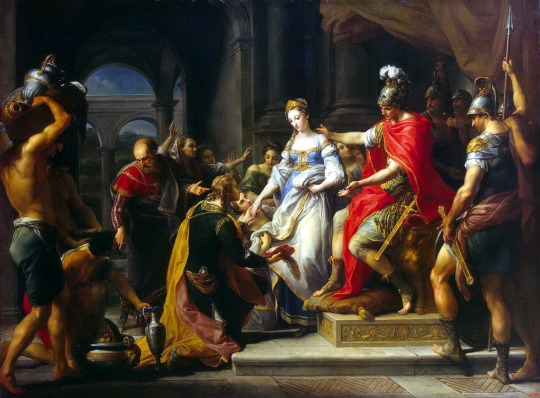
The Continence of Scipio by Pompeo Batoni
#scipio#art#pompeo batoni#publius cornelius scipio#scipio africanus#allucius#clemency#continence#ancient rome#roman#romans#roman republic#second punic war#punic wars#spain#hispania#iberia#iberian peninsula#cartagena#carthage#carthaginian#antiquity#rome#europe#european#history#livy#celtiberian#prince#titus livius
37 notes
·
View notes
Note
Mandatory ask about Iberia and her relationship with her boys after Caju's ask ♡
Yay! Hi Oxi!
Iberia was a warrior first, so she was strick with her boys, she made sure they knew how to fend for themselves, so she would strap them on her back and take them to the montains and the woods to hunt and train. When Rome came over, she would send them to him because the bastard had to do his part. They were like bitter divorced parents.
As the oldest, I think she was particulary strick with Lusitania. He had to look after Hispania, make sure he didn't die eating poisoned berries or wandered off to be eaten by wolves. He'd also spend more time with her, since he ran away from Rome so often, listening to her stories, fishing, hunting and braiding their hair (like her, Lusitania kept his hair long no matter how much Rome wanted him to cut it). She would also threathen to castrate Rome whenever he insinuated her boy was a barbarian.
Hispania was her baby boy. She was strick with him, but he managed to win her over with his bright smile and cuddling with her. I like to think Hispania wanted his mama and papa to get along, wanted his big brother to get along too, but they were all so stubborn! Plus, Hispania was daddy's boy, he worshiped Rome, which made Iberia a bit sad, but also furious whenever Rome disappointed her baby by not visiting when he had promised.
I said it before, but I think the relationship was complex because Iberia knew her sons birth meant her time was coming to an end. She loved them and wanted to make sure they would be okay when she was gone. Also, two sons meant her land was going to be divided and that hardly ended well. Like Romulus and Remus, she knew her sons would end up fighting each other, maybe one would even kill the other. It was just the way things worked.
#hetalia#aph portugal#hws portugal#hws spain#aph spain#aph iberia#hws iberia#hws ancient rome#aph ancient rome#iberian brothers
26 notes
·
View notes
Text
Timucuan Indians are the Tamerikhans
Timucuan Indians are the Tamerikhans
Timucuan Indians are the copper colored or swarthy Tamerikhans (Tameri-Khans) depicted on the 1657 map of La floridas which has the Nationality of Tamerikaans listed under the plaque of La Floridas on this map.
Additionally, Timucuan are Tamerikhan are etymologically and phonetically the same word due to similar spelling and similar pronunciation. However, let’s break it down even further…

View On WordPress
#Abyssinia#Ancient Cush#Ancient Ethiopia#Assyria#Assyrian Empire#Ethiopia Superior#Gothic Architecture#History of Jacksonville#Iberian Peninsula#La floridas#Nineveh#Old World Florida#Picts#Prester John#Saint Augustine Florida#Saint Thomas#Tameri#The Fountain of Youth#the Garden of Eden#Timucua People#Timucuan Indians
6 notes
·
View notes
Text
ORETANI
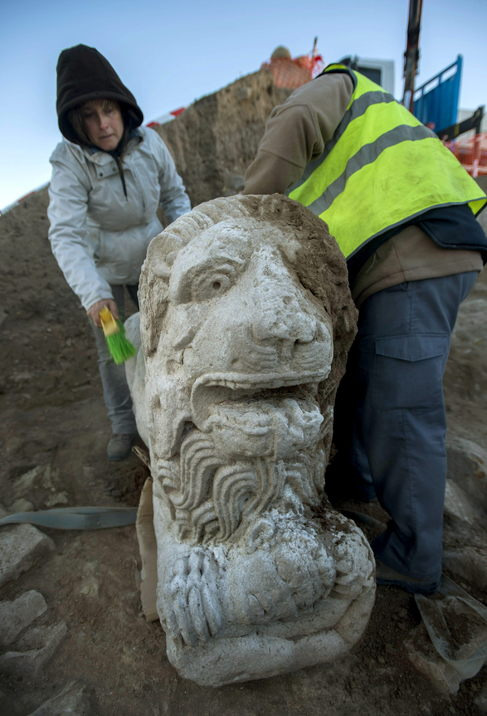

(a lion statue found in the archaeological site of Castulo, and an Oretani warrior)
The Oretani were an Iberian group that lived in Northern Andalusia and Southern La Mancha, concentrated in the modern provinces of Jaén and Ciudad Real, with some dispersion into Córdoba and Albacete as well. Attested as early as the 5th century BC, the largest oppida or settlements, characterized by its great fortifications, were Ipolca (roman Obulco and modern Porcuna, Jaén) and Kastilo (roman Castulo, near modern Linares, Jaén). Due to its location next to rich mines, Kastilo / Castulo was one of the most important cities in Iberia not only during the Iberian era but also within the Roman Empire and beyond; it was head of a diocesis until the 15th century when it was abandoned, and it has been deemed as "the Iberian Pompeii" due to the richness of its materials and the state of the ruins. Meanwhile, Ipolca / Obulco has a so-called "Heroon", a sanctuary / temple in honour of a mysterious hero. Other significant sites were Puente Tablas (Jaén) and Torreparedones (Baena, Córdoba).

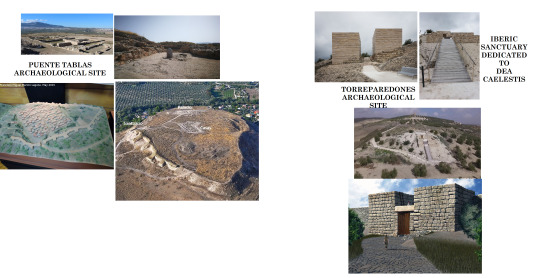
The Oretani also had some of the most impressive and largest sanctuaries in all of the Iberian world, like the rock ones in El Castellar or El Collado de los Jardines, both in Jaén. The sanctuary at Castellar was inside of a cave called Altos del Sotillo, in which every equinnox the light would penetrate and create a religious experience. Meanwhile, the Collado de los Jardines one sat inside the Cueva de los Muñecos [Cave of the Dolls], in Despeñaperros, a gorge that separates Andalusia and Castille, and as the name suggests, thousands of votive images have been found here.
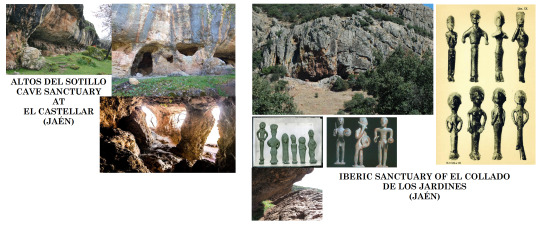
The Oretani defeated Hamilcar circa 230 BC in the Battle of Helike (near modern Elx), after the 'king' of the Oretani, Orisson, came to aid the locals against the Punic siege of the city. Later on, however, the king's daughter, Himilce, was married to Hannibal as part of a pact between the Carthaginians and the Oretani. After the Second Punic War, it became part of Rome.

#typicalspanish#oretani#ancient iberia#iberia#history#ancient history#prerroman spain#himilce <333333#and the heroon of castulo!!!! i went to a conference where they tried to reconstruct what the myth of this hero would've been#also about castulo#i think i didn't convey how important it was#like it was the single most important and probably largest city in prerroman iberia#if the iberians for some reason had united into a single political entity castulo would've been the capital#even the cities around it today (baeza and linares) are one of the most important cities of jaén and are pretty significant in andalucia#speaking of jaén#the national iberian museum is in jaén city#it is THE center of all iberian stuff#i want to visit it so bad#also all my class notes on prerroman iberia disappeared when my computer decided to erase random stuff lol#so i had to rely on the manual de la uned i love you very much#btw fellow spaniards if you need to learn about an academic topic the uned manuals are a godsend#i could access this one online through my university and i imagine there's free access to them through any spanish university
11 notes
·
View notes